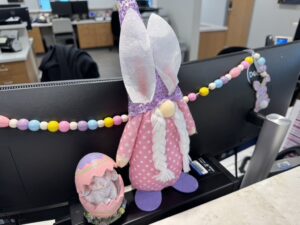 I join Bishops Brookhart, Gomes, and Little and Canon McCarthy in extending greetings and blessings for Easter Day and Eastertide. Whatever troubles you, whatever in your personal or our national life you would change, may the light from the empty tomb be your reassurance and guide as we make common cause with all people of faith to bring the realm of God closer, however and whenever we can.
I join Bishops Brookhart, Gomes, and Little and Canon McCarthy in extending greetings and blessings for Easter Day and Eastertide. Whatever troubles you, whatever in your personal or our national life you would change, may the light from the empty tomb be your reassurance and guide as we make common cause with all people of faith to bring the realm of God closer, however and whenever we can.This year, studying Luke’s Resurrection account, I noticed for the first time the way two important participants finish each other’s sentences. When Mary Magdalene, Joanna, and James’ mother Mary go to anoint Jesus’s body, they encounter the men in dazzling clothes, who say, “Why do you look for the living among the dead? He is not here, but has risen.”
The Greek text says “they” speak instead of “the men.” Either way, it’s plural. Did they speak at the same time? If so, the revelation of the good news to the first three apostles has the quality of any service in which we and our siblings speak in unison. If the church of the risen Christ was born in this moment, then this is the first instance of Christian liturgy.
“Why do you look for the living among the dead? He is not here, but has risen.” When someone is sick or dying, or portents of the death of our dreams overtake us, let us return to the assembly, grab a bulletin or prayer book, stand next to our beloved or our friend, and reach for the promise of new life by raising our voices as one. For now, if you say them once more in your head, I promise these words will sing in your heart all day. “Why do you look for the living among the dead? He is not here, but has risen.”
[Members of the Episcopal Diocese of Los Angeles received this letter via email this morning in English and Spanish. If you would like to be on the mailing list, please let me know in Messenger. Photo: Early Easter in a medical office at PIH Health Good Samaritan Hospital]
